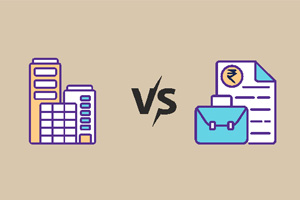What would you choose between the allure of all things grand and tall and the beauty of those petite and small? Bigger things have grandeur, but the little moments steal your heart. If you have watched a cricket match, you can vouch for the fact that the slight, delicate spin of a ball can be as poignant as the big sixes steered towards the crowd. Talking about small and big, the investing world too has small and large companies, each offering remarkable potential for financial growth. If you are choosing between large-cap vs small-cap funds, it is important first to understand their nuances and then take a call. Keep reading to know more!
What is a large-cap fund?
A large-cap fund is a mutual fund scheme that invests in the stocks of large-cap companies. Companies are ranked in terms of their market capitalisation, which refers to the total market value of a company's outstanding shares. As per the Securities and Exchange Board of India (SEBI), large-cap companies are ranked from 1st to 100th in terms of total market capitalisation.
Large-cap funds invest in companies with the highest market capitalisation in the market. These companies are stable, well-established, and leaders in their fields. As a result, these funds can offer steady growth without being too vulnerable to market volatility.
What is a small-cap fund?
A small-cap fund is a mutual fund scheme that invests in the stocks of small-cap companies. SEBI categorises companies ranked from 251 onwards as small-cap companies. These companies are in the early stages of growth, because of which they can be more sensitive to market volatility. But they also have the potential for higher growth compared to more established companies due to their innovative business models.
Large and small-cap funds have many other differences apart from these general characteristics. Let's have a look at them.
Difference between large-cap funds and small-cap funds
Points of difference | Large-cap funds | Small-cap funds |
Invests in | Large-cap funds invest in the top 100 companies in terms of market capitalisation. | Small-cap funds invest in companies ranked from 251 onwards in terms of full market capitalisation. |
Fund composition | Large-cap funds are open-ended equity funds that invest 80% of their total assets in equity and equity-related instruments of large-cap companies. | Small-cap funds are open-ended equity funds that invest 65% of their total assets in equity and equity-related instruments of small-cap companies. |
Risk | Large-cap funds invest in companies that are relatively more stable and hence carry lower risk. | Small-cap funds invest in newer companies that are still growing. As a result, they carry relatively more risk. |
Investor profile | Large-cap funds are suitable for investors with a conservative risk appetite. | Small-cap funds can carry higher risk and may be suitable for investors willing to take on more risk. |
Which is better for investment, large-cap funds or small-cap funds?
The large-cap vs small-cap debate can be easily solved by aligning your goals with your decisions. If you are looking for stability to weather market downturns and economic storms, large-cap funds may be suitable for you. On the other hand, if you are looking for an investment with the potential to grow over time, small-cap funds may be ideal for you. You must also keep in mind that the risk profile of these two types of mutual funds greatly varies. While large-cap funds carry low risk, small-cap funds may not withstand short-term market fluctuations and expose you to high risk.
Conclusion
Ultimately, the choice between large-cap and small-cap funds depends on your investment objectives, time horizon, and risk tolerance. You can consider allocating a portion of your money to both large-cap and small-cap funds to balance out risk and returns. You can also consult with a financial advisor and make an informed decision based on your unique needs and the professional's suggestions.
An investor education initiative by Edelweiss Mutual Fund
All Mutual Fund Investors have to go through a one-time KYC process. Investors should deal only with
Registered Mutual Fund (RMF). For more info on KYC, RMF and procedure to lodge/redress any
complaints, visit - https://www.edelweissmf.com/kyc-norms
MUTUAL FUND INVESTMENTS ARE SUBJECT TO MARKET RISKS. READ ALL SCHEME-RELATED
DOCUMENTS CAREFULLY
Trending Articles
MUTUAL FUND INVESTMENTS ARE SUBJECT TO MARKET RISKS, READ ALL SCHEME RELATED DOCUMENTS CAREFULLY.




















